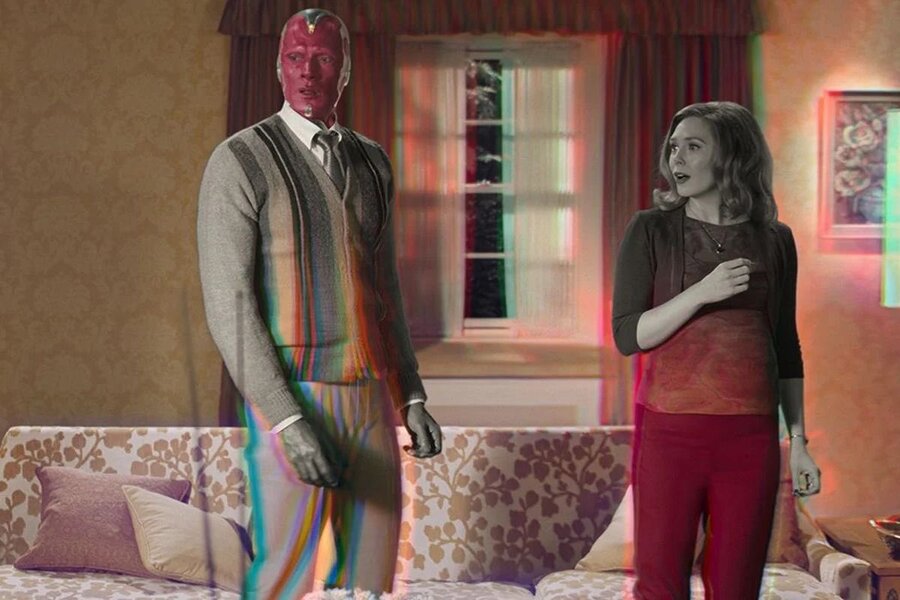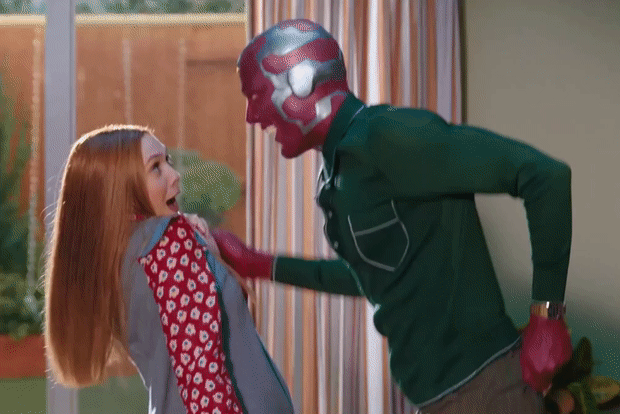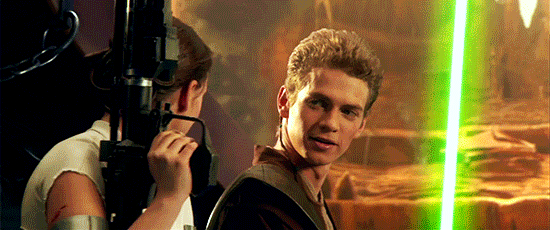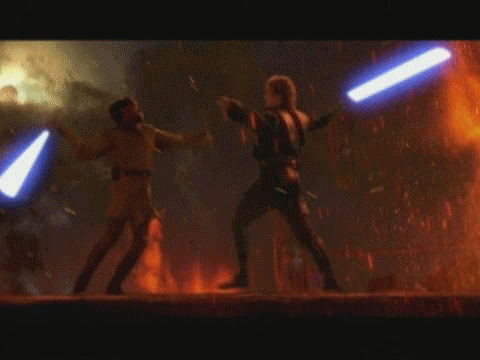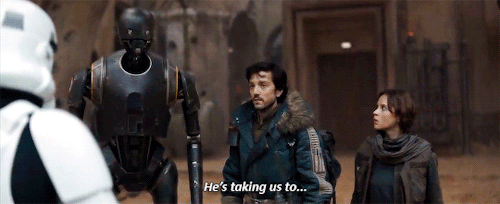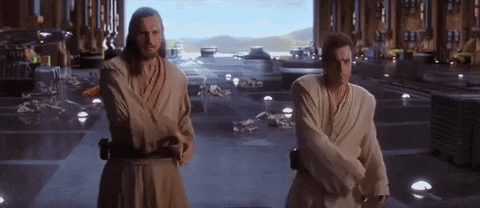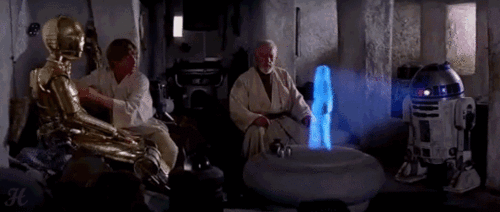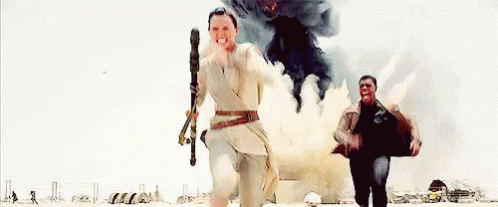
“STAR WARS: EPISODE VIII – THE LAST JEDI” (2017) Review
Following the success of the Disney Studios’ first hit STAR WARS film, “STAR WARS: EPISODE VII – THE FORCE AWAKENS”, I had assumed that producer-director J.J. Abrams would helm the next chapter in the franchise’s Sequel Trilogy. I was eventually surprised to learn that Lucasfilm president, Kathleen Kennedy, hired writer-director Rian Johnson to both write and direct “EPISODE VIII”.
My positive reaction to the news about Johnson being hired by Lucasfilm originated with my reaction to his 2012 film, “LOOPER”. I found Johnson’s 2012 film to be original, ambiguous and well written, if not perfect. I had hoped Johnson would create a better STAR WARS film than J.J. Abrams, who was the creator behind the 2015 movie. Then the movie hit the theaters in December 2017 and I was relieved by the high level acclaim it had received from the critics.
Titled “STAR WARS: EPISODE VIII – THE LAST JEDI”, this 2017 movie picked up immediately after the last scene of the previous Sequel film. Well . . . almost. Actually, “THE LAST JEDI” about an hour before “THE FORCE AWAKENS” ended, or around the same time. The movie opened with the Resistance forces abandoning their base on D’Qar during an attack by the First Order. Resistance pilot Poe Dameron disobeyed General Leia Organa’s order to retreat and led a costly counterattack that destroyed a First Order dreadnought, but following the Resistance’s escape into hyperspace, the First Order managed to track them using a code and continue its attacks. Leia demoted Poe for disobeying her order and leading many of their pilots to their deaths. Following another attack by the First Order, Leia is seriously injured, leaving the Resistance leadership in the hands of her second-in-command, Vice-Admiral Holdo. Meanwhile, Rey, Chewbacca and R2-D2’s arrived at Ahch-To. Rey tried to recruit Jedi Master Luke Skywalker to help his sister Leia and the Resistance. But Luke; disillusioned over his failure to successfully mentor his nephew, Ben Solo aka Kylo Ren; refused to leave Ahch-To. He also refused to train Rey in the ways of the Force. Initially.
Following the opening battle between the Resistance and the First Order, former stormtrooper Finn recovered from the wound he had suffered in “THE FORCE AWAKENS”. He discovered that Rey was missing and that the fleeing Resistance was being tracked by the Force Order. Fearful that Rey might return and find herself in a tenuous situation, Finn decided to leave and track her down. Only he was stopped by a maintenance worker named Rose Tico. Grieving over her sister, who had been one of the bomber pilots killed in the opening, Rose believed that Finn was defecting. Once she realized otherwise; she, Finn and Poe devised a secret mission to find a code breaker to disable the First Order’s tracking device. Not long after Rey began her training under Luke, she discovers that she has a Force bond with her enemy, Kylo Ren. And without bothering to tell Luke, Rey and Ren begin communicating with each other.
I have to be brutally honest. I did not like “THE FORCE AWAKENS”. Not really. I thought the 2015 movie suffered from too many plot holes and felt like a remake of the 1977 movie, “STAR WARS: EPISODE IV – A NEW HOPE”. Being a fan of Rian Johnson’s 2012 movie, “LOOPER”, I had high expectations for “STAR WARS: EPISODE VIII – THE LAST JEDI”. I hoped that the film would improve J.J. Abrams’ work on the previous film. Fortunately, I found a good deal to admire about the film.
One of the aspects of “THE LAST JEDI” that I truly admired was its visual style. I had nothing against the 2015 movie’s visual style. But if I must be honest, “THE LAST JEDI” took it to another level. Steve Yedlin’s photography struck me as sharp and colorful in scenes that featured the movie’s opening battle; and the duel inside the throne room, aboard Snoke’s starship the Supremacy. Yedlin’s photography assumed a rich and sleek style in the Cantonica sequence that featured the Canto Bight casino and the escaped animals chase scenes, as shown below:


However, Yedlin’s photography would have been something of a waste, if it were not for Rick Heinrichs’ production designs and the Art Direction team led by Kevin Jenkins. This was especially the case in Snoke’s blood red throne room aboard the Supremacy, Luke Skywalker’s habitat on Ahch-To and . . . of course, the Canto Bight Casino. What can I say? I really enjoyed the visual aspects of that scene. Between the photography, the visual design and the whole elegant, yet corrupt atmosphere of the scene; I have not been this impressed by a visual setting in a “STAR WARS” scene since the Outlander Club sequence in 2002’s “STAR WARS: EPISODE II – ATTACK OF THE CLONES”.
If I must be honest, I never really had a problem with the acting in “THE FORCE AWAKENS’. Nor did I have a problem with the performances in “THE LAST JEDI”. In fact, I would go as far to say that the performances of three cast members actually improved. One of them was veteran actress, Carrie Fisher. As many know, Fisher passed away during the last week of December 2016. I must admit that I was not that impressed by her portrayal of the aging Leia Organa Solo in “THE FORCE AWAKENS”. In “THE LAST JEDI”, she managed to regain a good of her sharp and natural style, despite being missing from the film’s middle acts. Another improvement came from Domhnall Gleeson’s portrayal of General Armitage Hux, a high-ranking commander of the First Order. Personally, I found his performance in “THE LAST JEDI” rather strident. A bit of that stridency managed to manifest in the film’s first twenty minutes; but otherwise, Gleeson’s performance struck me as good deal more subtle. I thought Gleeson did a first-rate job in conveying Hux’s negative realization that an overemotional man child had become his new leader. Daisy Ridley’s portrayal of the former scavenger/potential Jedi Rey struck me as an improvement over her performance in “THE FORCE AWAKENS”. Her performance struck me as a lot less labored and more subtle – especially in her scenes with Mark Hamill. However, I still believe that her best performance, so far, was the 2017 Agatha Christie movie, “MURDER ON THE ORIENT EXPRESS”.
However, those performances from other returning cast members were just as first-rate as they were in “THE FORCE AWAKENS”. Oscar Isaac finally received more scenes to strut his stuff as energetic Resistance X-wing pilot and squadron commander, Poe Dameron. Granted, there were moments when he came off as a bit too energetic. Otherwise, I had no problems with his acting. I can also say the same about Adam Driver’s portrayal of the villainous Force user, Kylo Ren aka Ben Solo. I have a confession to make. I do not like the Kylo Ren character. But I do believe that Driver provided some excellent acting in this film and did his very best in injecting as much ambiguity as director Rian Johnson would allow. I had feared that when given full reign, Andy Serkis’ voice performance as Supreme Leader Snoke, would go over-the-top. Well, in the Snoke’s throne room scene, it nearly did. But in the end, Serkis eventually kept his performance under control and gave a very sinister performance. Lupita Nyong’o returned to provide the voice of Maz Kanata, the former pilot and smuggler who owned a tavern on Takadona. Her role in “THE LAST JEDI” was brief, the actress provided one of my favorite moments in the film as her character provided information about a code breaker to Finn, Poe and Rose; while fighting off a “union dispute” in the middle of a hologram transmission. As usual, Nyong’o was wonderful. I read somewhere that Johnson had originally planned for the Finn character to remain in a coma throughout most of the film. Eventually, Leia came very close in experiencing that fate. Thankfully, actor John Boyega did not have spend most of the movie lying on a bed or platform. Instead, audiences got to, once again, enjoy Boyega engage in his own kind of magic, as the movie sent his character, former stormtrooper Finn, into new adventures.
“THE LAST JEDI” featured first-rate performances from newcomers like Laura Dern, Kelly Marie Tran, Benicio del Toro and yes, even Mark Hamill. Vice-Admiral Amilyn Holdo is another character that I am not particularly fond of. But I must that actress Laura Dern gave her usual competent performance as the Resistance leader forced to step in when Leia fell into a coma. Benicio del Toro gave a very sly and entertaining performance as a sly and treacherous codebreaker found himself a prisoner on Canto Bight. Kelly Marie Tran proved to be the newest addition to the Star Wars mythos as a Resistance mechanic named Rose Tico, who found herself grieving her sister Paige, following the latter’s death around the film’s beginning. Tran gave a very strong performance as the emotional, yet strong-willed and determined Rose. She also managed to form a solid screen chemistry with Boyega and Isaac. Technically, “THE LAST JEDI” proved to be Hamill’s second appearance in the Sequel Trilogy. However, he only appeared briefly in the 2015’s last scene without any dialogue. Thankfully, Hamill was able to strut his stuff as the older and somewhat embittered Luke Skywalker. Although his characterization in this film proved to be controversial, I cannot deny that Hamill gave a superb performance, as usual. It seemed a pity that he never had any scenes with Boyega. I would have given my right arm to watch those two share a scene together.
Is there anything else about “THE LAST JEDI” that I enjoyed? Honestly? No. Despite the fine performances, the excellent photography and superb production and art designs, I was not impressed by the movie. In fact, my opinion of the film proved to be lower than my feelings about “THE FORCE AWAKENS”. And I never thought that would be possible. I had two major problems about the film – the narrative and characterizations written by the director, Rian Johnson.
One of the main problems I had with “THE LAST JEDI” proved the length of time between it and “THE FORCE AWAKENS”. Judging from the film’s opening, the Resistance had fled its base on D’Qar and engaged in that opening battle against the First Order before Rey, Chewbacca and R2-D2 arrived on Ahch-To. Why did Johnson decide to begin the movie with such a small time frame? I have no idea. But thanks to this time frame, I found some of the events in the movie rather questionable.
According to the film’s opening crawl, the First Order had “decimated” the Republic and took military control of the galaxy. I found this hard to swallow. Yes, the First Order used their Star Killer weapon to destroy the New Republic’s capital and a few planets in the same system. But the Republic was spread all over the galaxy. Also, the First Order had suffered two major defeats near the end of “THE FORCE AWAKENS” – at Takodana, where it was searching for the BB-8 droid and the map to Luke Skywalker; and the destruction of the Star Killer weapon and its base. The last defeat proved to be a severe one for the First Order. Why would the entire galaxy surrender to the First Order when its super weapon, the Star Killer base and God knows how many troops and personnel were destroyed by the Resistance? I can understand the First Order licking its wounds and eventually conquering the rest of the Republic and going after the Resistance – but not so damn soon. Not within a space of one or two days.
The time frame produced another problem. After Snoke had punished General Hux for the Resistance’s destruction of the First Order’s new starship, the Dreadnought; the general informed his leader that he had used a new tracking device to follow the Resistance fleet through hyperspace. How exactly did this happen? When did Hux find the time – between the First Order’s defeat at Takodano, the destruction of the Star Killer’s base and the Resistance’s abandonment of their D’Qar base – to connect a tracking device to the Resistance convoy? When? I checked the Wookiepedia website on this hyperspace tracker, I discovered that it simply provided nothing more than a vague description. The website also failed to describe how Hux managed to have it planted in the first place. That is when I began to wonder if this tracking device was nothing more than a deus ex machina created by Johnson to keep the First Order on the heels of the Resistance fleet.
I have other problems regarding the First Order’s pursuit of the Resistance. One, how did the Resistance’s bomber fleets managed to drop bombs on the the dreadnought ship . . . in space . . . where there is no gravity? Would it have not been more sufficient for them to use the torpedo launchers of their X-wing fighter ships? Once the First Order managed to somewhat catch up with the Resistance fleet, it just basically kept its distance, while taking potshots at various Resistance ships; claiming that their enemy moved too fast for them to sufficiently destroy its convoy. What???? Did Hux fail to notice that the Resistance convoy was not particularly moving that fast? And whether the Resistance convoy was moving too fast or not, neither Hux, Snoke or Kylo Ren even bother to consider ordering part of the First Order’s fleet to jump into light speed ahead of the Resistance . . . and box the latter into a trap?
Rian Johnson’s handling of the Resistance proved to be equally problematic. A conflict has developed among the franchise’s fans on who was right – General Leia Organa or Commander Poe Dameron – regarding the bombing of the First Order’s dreadnought. Poe’s determination to destroy the dreadnought led to the destruction of Resistance’s bomber squad. On the other hand, if the dreadnought had continued to exist, who knows what would have hap . . . You know what? I do not give a shit one way or the other. I do not care. I found other things to complain about this story arc. I understood why Poe Dameron had blatantly ignored Leia’s order to retreat at the movie’s beginning. I do not understand why Paige Tico and the other bomber pilots did not follow her order. Surely, they had overheard Leia’s retreat order over the fleet’s communications system. And yet . . . like Poe, they ignored her order. And then we have Leia’s “Mary Poppins” moment, after the bridge of her flagship was destroyed. You know . . . the scene in which she used the Force to float back to her ship, after she and Admiral Ackbar (we hardly knew you pal!) were blown into space. I cannot believe that one of my last visions of Carrie Fisher on the screen was that ludicrous moment. God!
After Leia became incapacitated, Vice-Admiral Holdo took command of the Resistance. Chances are that Poe and some other members of the Resistance would have refrained from staging a mutiny . . . and sending Finn and Rose Tico on that mission to Canto Bight, if Holdo had informed everyone about hers and Leia’s plan to evade the First Order in thie first place. Only she did not. When she finally did, Poe and a few others dismissed it as cowardly and decided to stage a mutiny. This “mutiny” eventually led to Finn and Rose’s mission to search for a master code breaker at the Canto Bight Casino. I have one or two problems with this scenario. One, I could not understand why Holdo kept the evacuation plans a secret for so long, since it did not require a “need-to-know” reason. And two, why did Holdo wait so long to set hers and Leia’s plans in motion? Not only did I find this delay unnecessary, it allowed other factors in the story – Finn and Rose’s Canto Bight mission to affect the actual evacuation. One could dismiss this as an example of Holdo’s personality flaws. But the timing of this story arc makes it difficult for me to do this.
Leia and Holdo’s evacuation plan and gas lighting of Poe were not the only problems I had with their characters. I also had a problem with their costumes. Do not get me wrong, I found the costumes designed by Michael Kaplan rather elegant and lovely, as shown below:


But I could not help but wonder why both women wore outfits suited for dinner reception, a party or even a political meeting (in the STAR WARS universe). Their outfits seemed unsuited for military commanders in the field . . . especially military commanders who were attempting to guarantee the survival of those under them, in the middle of a life or death situation. Was this Kaplan’s attempt to outshine Trisha Biggar’s designs from the Prequel Trilogy. Who knows? Who knows? His costumes worked in the Canto Bight casino scenes. But they simply did not work for Leia and Holdo, who were not in elegant situations like the casino during this film.
Speaking of the Canto Bight mission . . . I honestly do not know what to say. It was such a crap fest to me. The only aspect of that mission that I enjoyed were the visual designs for the sequence. Otherwise, this whole story arc was marred by bad writing. Poe’s opposition to Holdo’s evacuation plan led him to send Finn, Rose and BB-8 to find someone who could break the code to the First Order’s tracking device, a master code breaker who hung out at the Canto Bight casino on Cantonica. So what happened? The pair landed their transport on a private beach and ended up getting arrested at the casino for illegal parking. Arrested . . . for illegal parking? Unable to contact the code breaker, due to being incarcerated behind bars, Finn and Rose met another prisoner named D.J., who claimed to be a code breaker. When he broke them out of jail, they recruited him to help the Resistance break the code . . . instead of returning to the casino in order to find the Master Code Breaker they had originally spotted. After the trio and BB-8 board Snoke’s ship, the Supremacy; Finn and Rose are betrayed by D.J., who also spilled the Resistance’s plans to escape from Leia’s cruiser via cloaked transport ships. Except . . . wait. How in the hell did D.J. know about that plan? He could not have learned everything about it from Finn and Rose, who only knew that Holdo and Leia had plans to evacuate. But they knew nothing about the transport ships being cloaked or that Holdo planned to send the Resistance to Crait. Hell, not even Poe knew the specific details, until he woke up aboard one the transports after being stunned by Leia. How did D.J. learn about Leia and Holdo’s complete plan?
I found something else rather odd about the Canto Bight mission. Finn and Rose were able to escape from Leia’s cruiser undetected and head for Cantonica in a cloaked transport ship. This sounds strangely similar to Leia and Holdo’s evacuation plan. I have already pointed out that the entire Resistance personnel could have done this and rendezvous at an arranged location a lot earlier in the story, instead of waiting until the last of the Resistance fleet was close to Crait. If Poe was able to help Finn and Rose slip away from both the Resistance convoy and the First Order fleet, why did he continue to oppose Leia and Holdo’s evacuation plan. Why did Poe believe that the evacuation plan was so cowardly (eyeroll) that he set in motion that ridiculous Canto Bight mission? I mean . . . honestly, Finn and Rose’s successful evasion of the First Order’s fleet and the Resistance convoy should have made him realize that Holdo’s plan – well, most of it – was pretty sound.
Another aspect of the Canto Bight story arc that I disliked was Rose’s revelations about the casino’s use of slave labor and the owners’ profiting from the conflict between the Resistance and the First Order, as arms dealers. Apparently, this entire story arc was created by Johnson for Finn to learn a valuable lesson about greed and corruption, enabling him to understand about what the Resistance is fighting against and drop his “selfish” concerns about Rey. WHAT . . . UTTER . . . BULLSHIT!!! There was nothing wrong with Finn being concerned about Rey not walking into the current conflict between the Resistance and the First Order. And there was no need for him to learn any damn lesson. And I sure as hell did not appreciate watching Rose lecture Finn about the evils of corruption, let alone slavery. You know, originally I thought she and had been a former slave herself. Then I checked Wikipedia and discovered that Rose and her sister Paige had been smuggled off their homeworld by their parents, before they could be snatched by the First Order and forced into slavery. So, why did Johnson believe it was necessary for her to lecture Finn about slavery, when the latter had been enslaved by the First Order ever since he was an infant? If anyone was qualified to give that speech, it was Finn.
The Canto Bight sequence did not feature the only problematic scene between Finn and Rose for me. Another occurred during the Resistance’s defense against an attack by the First Order at an old Rebel Alliance base on Crait, near the film’s finale. In one scene, the remaining Reisistance fighters – which included Finn, Poe and Rose – charged at the incoming First Order forces in order to give the others time to make their escape. While the surviving fighters broke off from the charge, Finn decided to make a suicidal charge against the First Order siege cannon that threatened to break into the base. And guess what happened? Rose stopped Finn’s charge. And what was her reason? Well . . . let me quote her:
“We’re going to win this war not by fighting what we hate, but saving what we love!”
What . . . in . . . the . . . hell??? Let me get this straight. According to Johnson, it was fine for Vice-Admiral Holdo to sacrifice herself to prevent the fleeing Resistance from being destroyed before they could reach Crait. But Finn was not allowed to sacrifice himself against the First Order’s siege cannon, because . . . why again? Hatred? What made Rose believe that Finn’s actions were all about hatred for the First Order? And when did Johnson convey the idea that Finn’s suicidal charge was all about hatred on his part? And why did Johnson keep creating scenes that gave Rose an opportunity to lecture Finn for the slimmest of reasons? Or decide that she knew better than him? Were the Canto Bight casino and Crait scenes indicative of some racism on Johnson’s part? Is he just another person who regards people of color, especially those of African descent, as childlike? I wonder.
Then we come to Rey’s experiences with Luke Skywalker on Ahch-To. Most critics of “THE LAST JEDI” tend to focus most of their complaints about the Canto Bight mission. My strongest complaints against the film are all about Rey’s experiences from start to finish. Judging from the first scene between Rey and Luke Skywalker, I got the impression that Johnson had written his own version of Luke’s first meeting with Yoda in “STAR WARS: EPISODE V – THE EMPIRE STRIKES BACK”. Actually, this scene was one of many that seemed to remakes of those from the 1980 film and “STAR WARS: EPISODE VI – RETURN OF THE JEDI”. I do not know how to describe Rey’s first two days on Ahch-To. Unlike many other fans of the franchise, I had no problems with Luke tossing away his/Anakin’s old lightsaber that he had lost on Bespin. As far as I am concerned, it should have remained lost. However, I noticed that Luke’s initial rejection of Rey as a padawan struck me as a lot crueler than Yoda’s initial rejection some thirty or so years before. Actually, I was not that impressed by the dynamic between Rey and Luke. I hate to say this, but Daisy Ridley and Mark Hamill’s on-screen chemistry did not seem that interesting to me. There was another problem in this story arc. Rey ended up receiving very little training in the Force. How long did Luke train Rey? What? A few hours, before it was interrupted by Rey’s discovery of the whole Luke-Kylo Ren mess? It seemed like it. There was one scene that featured Luke milking a rather . . . busty alien called Thala-Siren that just . . . I found this just as embarrassing as Leia’s Mary Poppins moment. It did not help that the creature’s udders resembled those of women. Oh God. Also . . . is it just me or Luke did not seem like himself? He seemed rather cynical, in compare to his younger self. And snarky. Luke seemed more like the younger Leia and Han . . . or Mark Hamill. I understand the circumstances that led Luke to his exile and how it may have emotionally damaged him. But his refusal to leave Ahch-To in order to help Leia . . . just did not feel right. I just cannot see him initially refusing to help his own sister, whose life was endangered.
But that was nothing, until the movie revealed what led to Luke’s estrangement from his nephew, Kylo Ren. Rey learned from the latter that Luke had a vision of his nephew/padawan causing a great deal of destruction and briefly considered killing the sleeping Ben. Although he relented, Kylo/Ben woke up and spotted Luke with his lightsaber drawn. An enraged Ben killed Luke’s loyal padawans in retaliation and joined the First Order, because he felt betrayed. Let me make this clear. I am aware that Luke is capable of terrible deeds or allowing his anger to get the best of him. These traits were apparent in both “STAR WARS: EPISODE IV – A NEW HOPE” and “RETURN OF THE JEDI” when Luke had engaged in bouts of murderous rage. But to deliberately contemplate murdering his own nephew, because he had visions of a destructive future from the latter or Snoke’s influence? Luke Skywalker? I simply do not see it. He is not Obi-Wan Kenobi, who has proven to be not being above doing or suggesting something terrible for the greater good. Luke has always struck me as the type who needed to have his emotional buttons pushed in order for him to commit a terrible deed.
While most detractors of “THE LAST JEDI” had a problem with Luke’s characterization, I had an even bigger problem with Rey’s . . . and the story arc she shared with Kylo Ren. What in the hell was Rian Johnson thinking? He managed to create another story arc that I believe was marred by the time span between “THE FORCE AWAKENS” and “THE LAST JEDI”. The whole Rey-Kylo Ren story seemed wrong within the Sequel Trilogy’s time frame. As I had earlier pointed out, not long after Rey had began her brief training into the Force under Luke, she discovered that some mental Force bond had developed between her and the man who nearly killed her, Kylo Ren aka Ben Solo. This . . . Force bond led Rey to discover what Luke had nearly did to Ren. And this, along with her telepathic conversations with Luke’s nephew and visions of him being redeemed convinced Rey that it was necessary to travel to Snoke’s ship, the Supremacy, and save Kylo Ren and convince him to give up evil; evoking memories of Luke’s attempt to save his father, Anakin Skywalker, in “RETURN OF THE JEDI”.
When I watched as Rey decided to travel into “the bowels of evil” in order to save an overprivileged and murderous man child from himself and Snoke, I could not help but indulge in a massive face palm. Or groan. This was just simply ridiculous to me. Was I really expected to accept that Rey had developed compassion or any other kind positive feelings for Kylo Ren two to three days after what he tried to do to her in “THE FORCE AWAKENS”? Does anyone realize how unrealistic that is from an emotional point-of-view? After all, only two or three days had passed since Rey had witnessed or experienced the following in “THE FORCE AWAKENS”:
*Kylo Ren kidnapped Rey during the First Order’s attack on Takodana.
*As he had done earlier to Poe Dameron, Kylo Ren tried to violate Rey’s mind in order to learn Luke’s whereabouts, using telepathy. Only she managed to defend herself using the same method.
*Rey, Finn and Chewbacca witnessed Kylo Ren’s murder of his father, Han Solo.
*Kylo Ren tried to injure or kill Rey by tossing her into a tree, near the Star Killer base.
*Kylo Ren maimed Finn during a light saber duel.
*Rey engaged in her own light saber duel against Kylo Ren, in which she managed to wound him.
During Rey and Kylo Ren’s telepathic interactions in “THE LAST JEDI”, she managed to develop compassion for him. And I am at a loss at why she would do this over a person, who had caused so much harm to her and those she cared about . . . in such a short period of time. When Rey asked Kylo Ren why he murdered his father, the latter explained – in a scene in which he was shirtless (a massive eyeroll) – that trying to cut out any sense of emotional attachment. WHAT IN THE HELL???? That was his excuse? And she bought it? And when Rey questioned Kylo Ren’s murder of Luke’s loyal padawans, he revealed how Luke had contemplated on killing him. Never mind that I believed this did not jibe with Luke’s personality. This was a lame excuse on Kylo Ren’s part. Those padawans had not played a role in Luke’s brief contemplation to commit murder. Those padawans had done nothing to Kylo Ren or anyone he may have cared about. And yet . . . Rey failed to continue questioning Kylo Ren’s murders. She expressed anger at Luke’s behavior, which I do not blame her. But she also decided to use this and Luke’s reluctance to save his nephew as an excuse to surrender to Snoke in an effort to save Kylo Ren, someone who had wronged her and those whom she cared about . . . VERY RECENTLY. As far as Rey knew, Kylo Ren was not related to her and a long period of time had not passed between “THE FORCE AWAKENS” and “THE LAST JEDI”.
Another problem seemed to manifest this story arc – namely Rey’s visions of Kylo Ren’s future. I am not claiming that he was redeemable. But did Rey ever consider that her visions had been manipulated in the first place? Did she ever consider that her telepathic bond was manipulated, which the movie later confirmed during Snoke’s monologuing? I realize that Rey was somewhat naive. But considering her recent past experience with Kylo Ren attempting to violate her mind, she never considered that this might be another attempt? Or that he had successfully found a way to violate her mind and try to manipulate her? Apparently not. Instead, Rey simply jumped up and rushed to Snoke’s ship in an effort to “save” Kylo Ren. It seemed obvious that Johnson had set up this whole scenario in order to plagiarize the Palpatine throne scene from “RETURN OF THE JEDI”. Unfortunately for me, it failed on so many levels. Worse, it made Rey looked like “the Idiot of the Galaxy”. This entire story arc struck me as incredibly stupid.
One could say that Rey’s stupidity in the above scenario finally erased the Mary Sue label from her character. Perhaps. There was also the fact that in compare to Snoke, her mastery of the Force was a joke. He handled her like a toy doll in the Supremacy throne room sequence. And yet, she was able to master the Force with easy in other scenes. The movie’s novelization, written by Jason Fry, explained that the telepathic connection that Rey had unexpectedly formed with Kylo Ren enabled her to learn his skills with the Force. In other words, Rey is the “STAR WARS” version of Chuck Bartowski from the NBC series, “CHUCK”. For me, this was one of the most idiotic and lazy piece of writing that I have ever encountered in a movie or novel. To make matters works, the movie’s ending revealed that Rey had stolen Luke’s ancient Jedi texts. This seemed to be a hint that she will continue her Jedi studies using those texts. Jesus Christ! This scenario had failed when an Extended Universe (EU) novel used it to explain Luke’s development of his Force skills in “RETURN OF THE JEDI” after failing to return to Yoda on Dagobah for more training. This scenario strikes me as even more ludicrous, considering that Rey’s actual training lasted a hell of a lot shorter than Luke’s.
Rey also continued to display her Force skills in a lightsaber fight scene that featured her and Kylo Ren against Snoke’s guards. However, since the latter were not Force users, I would equate this scene with Obi-Wan Kenobi’s duel against General Grievous in “STAR WARS: EPISODE III – REVENGE OF THE SITH”. Utterly irrelevant. And to be honest, both Daisy Ridley and Adam Driver seemed like more proficient duelists in a You Tube video clip that featured them practicing the fight than they did in the movie. Whoever handled the lightsaber choreography for this film need more lessons on how to stage a fight between swordsmen.
Before Rey had made her escape from Snoke’s starship, Kylo Ren revealed to her that her parents were two-bit junk dealers on Jakku, who had sold her into slavery for drinking money. He did this in an effort to emotionally isolate her and manipulate her into serving his desires. Now, if what he said about Rey’s parents are true, who had abandoned Rey on Jakku and left the planet? If the people who had abandoned Rey on Jakku were her parents, then they had sold her for more than drinking money. Also, how and when did Rey ceased to be a slave? I read somewhere that Rian Johnson made Rey unrelated to the Skywalker family because he wanted to move the saga away from them. When I heard this . . . Jesus Christ! Do Disney and Lucasfilm even know what what the hell they are doing? If the main protagonists for the Sequel Trilogy are not supposed to be members of the Skywalker family, then why . . . regard . . . this . . . particular . . . trilogy as part of the Skywalker Family Saga in the first damn place? Why not simply regard this trilogy as something other than a part of the Skywalker family saga and utilize characters from the previous two trilogies as minor supporting characters – like 2016’s “ROGUE ONE”?
There were other characterizations that proved problematic to me. Many of the saga’s fans had complained about Snoke’s death and the fact that his background was never revealed or explored. I had no problem with this for two reasons. One, Palpatine’s background was never revealed until the Prequel Trilogy. Unless Lucasfilm plans to release films that featured Snoke’s backstory or the rise of the First Order, I must admit that as a character, he was a waste of time. And two, I am not a fan of Snoke. Despite Any Serkis’ excellent voice performance, Snoke struck me a ham-fisted and one-dimensional version of Palpatine. I could blame J.J. Abrams, who created the character in the first place. But the real blame lies on Rian Johnson’s shoulders, who had transformed the character from a somewhat mysterious villain to a one-dimensional remake of one of the best movie villains I have ever seen on screen.
Captain Phasma has to be one of the most wasted characters I have ever encountered in the science-fiction/fantasy genre. This character, who happened to be commander of the First Order’s stormtroopers, had less development than some of the one-shot villains in the saga. Hell, even General Grievous, whom I have always harbored a low opinion, was better written than her. Poor Gwendoline Christie. It was bad enough that Abrams wasted her character in “THE FORCE AWAKENS” by failing to show her in action. When she was finally featured in an action sequence in “THE LAST JEDI” – a control baton duel against Finn aboard Snoke’s ship – she was quickly killed off. And she was dispatched rather fast, due to . . . you know what? I do not know. I do not know why Johnson had shortened the Finn/Captain Phasma duel to such a ridiculously short length. I have come to the conclusion that Phasma was, in the end, a wasted character. If there was a character even more wasted than Captain Phasma, it was Admiral Ackbar, who had also appeared in both “RETURN OF THE JEDI” and “THE FORCE AWAKENS”. The Mon Calamari military commander was unceremoniously killed by the same blast that nearly killed Leia . . . before he even had the opportunity to utter a line. God, what a waste! Although Chewbacca was utilized more than Admiral Ackbar, his character had been reduced to a comic relief arc and a species called the Porg on Ach-To and Rey’s personal chauffeur. Despite having more screen time, poor Chewbacca proved to be wasted just as much as Phasma and Ackbar.
A relative of mine had pointed out that what made “THE LAST JEDI” unique was that it featured how the theme of failure in a STAR WARS movie. Others had pointed out that Rian Johnson managed to present a movie with a subversive narrative. I say bullshit to that. “THE EMPIRE STRIKES BACK” was the first STAR WARS movie that featured the failures of its protagonists. It was also the first film that subverted the mythos of the saga that Lucas had created. And guess what? The Prequel Trilogy was basically one long saga on how Anakin Skywalker, the Jedi and the Galactic Republic failed themselves. Also, the last third of “RETURN OF THE JEDI”, the Prequel Trilogy and “ROGUE ONE” were other movies that subverted the saga’s mythos. Rian Johnson had not created anything new. Not really. Also, both George Lucas and Gareth Edwards did all of this with better writing.
There were aspects of “STAR WARS: EPISODE VIII – THE LAST JEDI” that impressed me. I thought the film’s performances from a cast led by Mark Hamill, Daisy Ridley and John Boyega were either competent or first-rate. And I was more than impressed by the movie’s production values. But overall, I found “THE LAST JEDI” to be a major disappointment. And a great deal of this disappointment came from Rian Johnson’s screenplay – both the film’s narrative and characterizations. In fact, I dislike this film a lot more than I did “STAR WARS: EPISODE VII – THE FORCE AWAKENS”. I understand that J.J. Abrams, who had directed the Sequel Trilogy’s first film, will direct its third and final movie, “EPISODE IX”. Even if this movie proved to be enjoyable, I do not think it can save this new trilogy as a whole. After two very disappointing movies, the STAR WARS Sequel Trilogy has proven to be a disaster in my eyes.
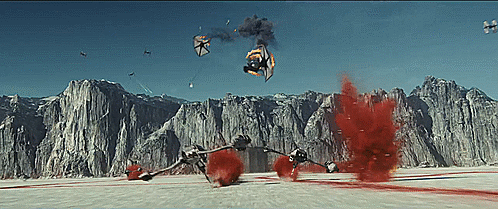
Filed under: Movies | Tagged: adam driver, andy serkis, benicio del toro, bill hader, billie lourd, carrie fisher, crystal clarke, daisy ridley, disney, domhnall gleeson, ewan mcgregor, frank oz, gwendoline christie, j.j. abrams, john boyega, joseph gordon-levitt, justin theroux, kate dickie, kelly marie tran, laura dern, lily cole, lupita nyong'o, mark hamill, movies, noah segan, oscar isaac, politics, rian johnson, star wars, travel, veronica ngo, warwick davis | 2 Comments »
